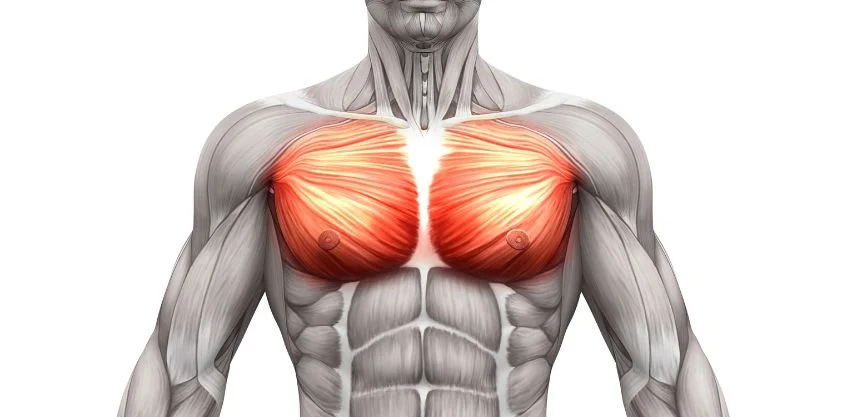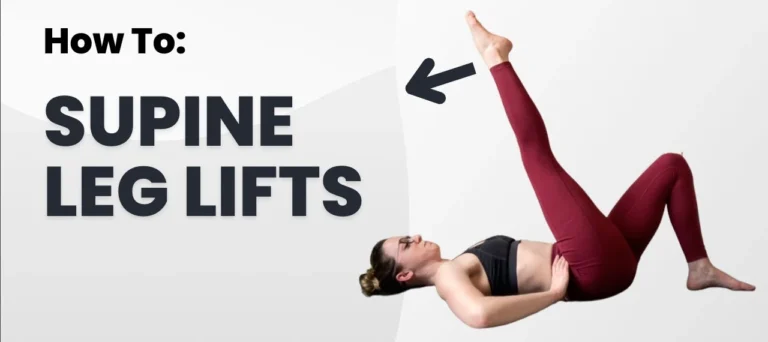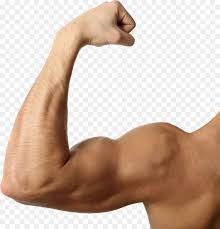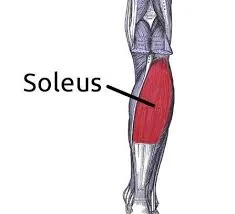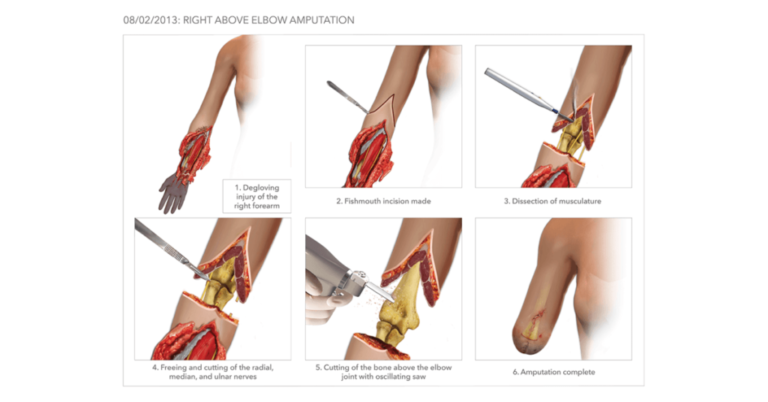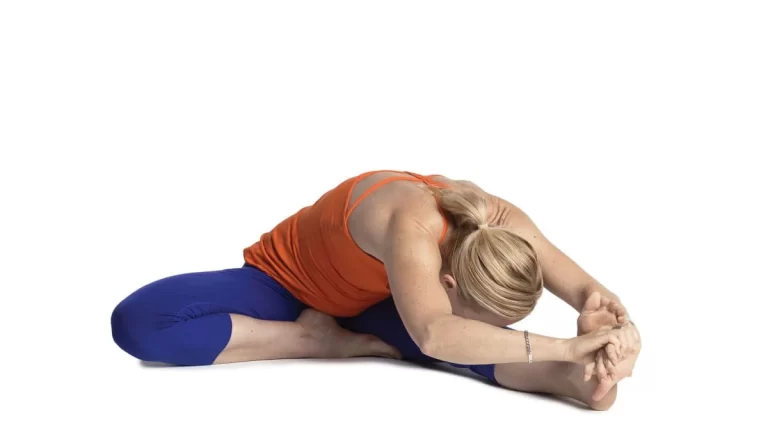Chest muscles exercise
Table of Contents
Introduction
- Chest muscles exercise increases, the strength of the chest muscle, In addition to improving your posture, strengthening and lengthening your chest muscles helps you to support your breathing pattern. That is because the pectoralis is attached to your rib cage, which expands with each and every inhale. The chest muscles keep you upright and ensure good posture.
- Chest Muscles are referred to as “Pecs” muscles. These muscles are Pectoralis Major, Pectoralis minor, Serratus Anterior, and Subclavius muscle.
- Chest muscles connect the front of the human chest with the bones of the upper arm and the shoulder. The pectoral region has 4 muscles that create movements to the upper limbs or ribs.
- The musculus pectoralis is the most superficial muscle in the pectoral region. it’s large and fan-shaped, and consists of the sternal head and the clavicular head: Both heads of the Pectoralis Major distally attach to the intertubercular sulcus of the humerus. The clavicular head of the Pectoralis Major origin from the anterior surface of the medial clavicle. Sternocostal head Pectoralis Major has origins from the anterior surface of the sternum, the superior six costal cartilages, and also the aponeurosis of the external oblique muscle. The Pectoralis Major main action is the adduction and the medial rotation of the upper limb. and it also moves the scapula in an anteroinferior direction. The individual action of the clavicular head of the Pectoralis Major is the flexion of the upper limb. The nerve supply of the Pectoralis Major Lateral and medial pectoral nerves.
- Pectoralis Minor: The pectoralis Minor lie underneath its larger counterpart muscle, the pectoralis major. Pectoralis Minor muscle has originated from the 3rd to 5th ribs and is inserted into the coracoid process of the scapula. The main action of the pectoralis muscle is to provide stabilization of the scapula by directing it in the anteroinferior direction against the thoracic wall. The nerve supply of the pectoralis minor is the Medial pectoral nerve.
- Serratus Anterior: The serratus anterior is found more laterally within the chest wall and makes the medial border of the axilla region. The muscle is made up of several strips, which have originated from the lateral aspects of ribs 1 to 8. serratus anterior has an attachment to the costal (rib-facing) surface of the medial border of the scapula. serratus anterior muscle’s main action is to rotate the scapula which allows the arm to flex over 90 degrees. It also helps to stabilize the scapula against the ribcage. The nerve supply of the serratus anterior muscle is the Long nervus spinalis.
- Subclavius: The subclavius is a tiny muscle and is found directly underneath the clavicle, running horizontally. The subclavius muscle provides slight protection to the underlying neurovascular structures like in conditions of clavicular fracture or another direct impact. It originates from the junction of the first rib and its cartilaginous structure and is inserted into the inferior surface of the center third of the clavicle. It Anchors and depresses the clavicle. The nerve supply of the v is the Nerve to the subclavius.
- Intercostal muscles: This muscle located between the ribs helps in breathing. The pectoral fascia is a thin layer of connective tissue located over the pectoralis major muscle, lengthening toward the latissimus dorsi muscle on the back.
- Chest muscle exercise includes two types of exercise:
- Strengthening exercise
- Stretching exercise
Health benefits of strengthening exercise of your chest muscles
- In addition to your back and shoulder muscles, your pectoralis muscle help to stabilize your shoulder joint.
- Strengthening exercise of your chest muscles improves their strength of the chest muscle.
- Better Breathing: In addition to improving your posture, strengthening and lengthening your chest muscles helps you to support your breathing pattern. That is because the pectoralis is attached to your rib cage, which expands with each and every inhale.
- A strong chest also increases the strength of your back muscles.
- The chest muscles keep you upright and ensure good posture.
- It Targets your pectorals, deltoids, and triceps, building muscle tissue and strength.
- It also works on your serratus anterior and biceps. These upper limb muscles’ strength
- It also Helps with the activities of daily living like pushing strollers, shopping carts, and heavy doors.
Strengthening exercise
Incline push up
- How to do it?
- This is a very good exercise to warm up your chest muscles for work.
- For the Incline push-up exercise, you have to begin with your hands on the wall or a countertop-height surface. move your feet back so that your body makes roughly a 45 to 50-degree angle with the ground.
- Your body should be straight and also your spine should be neutral, and lower your chest to the surface you are leaning against.
- You can hold for two seconds, then return to the beginning position.
- You have to Make sure the resistance feels light enough to complete up to 25 reps. If you want to make this exercise easier, step closer to your hands to make this exercise tough, step farther away.

Flat bench press
- How to do it?
- For the flat bench press, you need a barbell or dumbbell, a flat bench.
- Take a supine lying position on the bench with your knees bent and feet flat on the floor. hold the barbell, with your thumb wrapped around the dumbbell or barbell and palms facing toward your feet. Press your arms straight toward the ceiling to raise the bar from the rack.
- Move the barbell over the level of the chest.
- Flexed your elbows down at a 45 to 50-degree angle, and slowly lower the barbell to your chest. Keep the barbell approximately in line with your 4th intercostal space.
- Then Pause for a moment, then press the barbell back to the starting position.
- You can Complete 2 sets of 10 to 15 repetitions.
- your back should be flat and maintain great control of the weight. Also, keep your neck neutral to avoid strain. It is recommended to enlist the help of the spotter to ensure safety in this exercise.
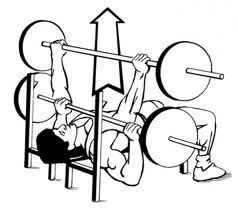
Incline bench press
- How to do it?
- For an Incline bench press, you need a barbell or dumbbell, and an incline bench.
- Lie on your back on the incline bench with your knees bent and feet flat on the ground. hold the dumbbells, with your thumb wrapped around the dumbbells and palms facing toward the feet. Press your arms straight toward the sky to lift the barbell from the rack.
- Slowly lower the dumbbells down to your chest, approximately in line with your mid-chest to just above your fourth intercostal space.
- Pause, then press the weight back to the starting position.
- You can Complete 3 sets of 10 to 14 repetitions.
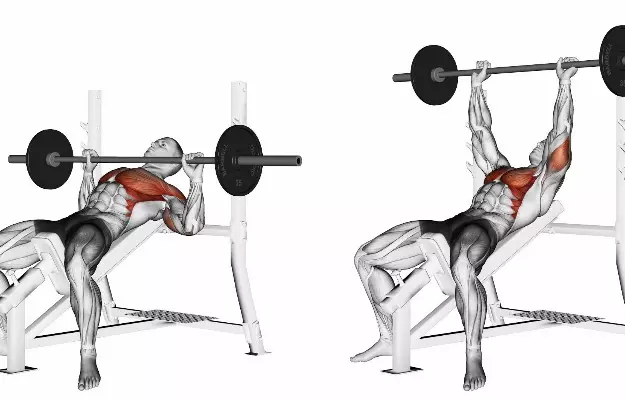
Decline bench press
- How to do it?
- For the decline bench press, you need a barbell or dumbbells, and the decline bench
- Takes a supine lying position on the decline bench, with your knees bent and ankles secured behind the ankle rests. hold the bar, with your thumb wrapped around the barbell and palms facing toward your feet. Press your arms straight to lift the barbell from the rack.
- Position the barbell above your lower chest to the upper abdomen level.
- Slowly bent your elbows to lower the barbell down to your chest, approximately in line with your nipples.
- Pause, then press the barbell back to the starting position.
- You can Complete 3 sets of 10 to 12 repetitions.
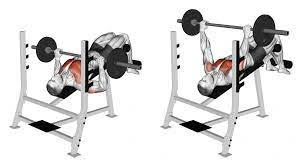
Pushup
- How to do it?
- Start on your hands and knees, and step back into the high plank position. keep your hands wider than the shoulders, and your legs should be straight with your quadriceps. Your hamstrings muscle should be engaged and your spine should be neutral.
- Your core muscles should be tight, Bend your elbows up to a 45 to 50-degree angle to lower your chest toward the ground, maintaining a straight line from the head to heel.
- the main goal is to go as low as you can without losing the support of your core muscles or the alignment of your spine and pelvis.
- Press your chest away from the ground until your elbows are extended.
- Repeat, completing 10 to 15 repetitions. Do 2 to 3 sets.
- If you want to make this exercise more challenging, then you can do the decline pushup by placing your toes on an elevated surface such as a bench or table.
Cable crossover
- How to do it?
- For the Cable crossover, you will need a cable machine or a resistance band.
- For this exercise, you have to stand away from a set of a high pulley cable machine or the resistance band anchored overhead. Select light to moderate weight to add some more challenge but give you proper form.
- Hold the ends of the resistance band as you step forward with one foot. You have to create enough tension and control on the handles to keep them in front of your body.
- Engage your chest muscles and bring the handles down and forward across your body roughly up to your umbilicus. The hands can cross to add emphasis on the serratus anterior muscles.
- You can hold for two to three seconds and then slowly return to the starting position. Then repeat.
- Do 2 sets of 16 to 20 repetitions.
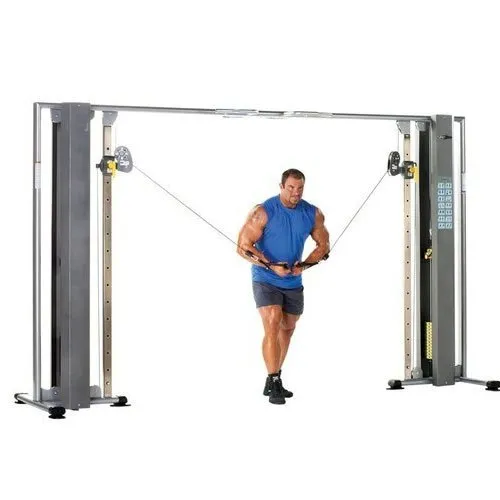
Chest dip
- How to do it?
- You need a dip station.
- For the Chest dip exercise, you have to stand with the two parallel barbells and hold them, palms facing in.
- Extend your elbows and press into your hands, lifting your body so that it is in the line with your hands.
- Then, bend your elbows and lower the weight toward your hands.
- You can hold for a second then press back to the starting position. Then Repeat.
- You can do 3 sets of 8 to 16 repetitions.
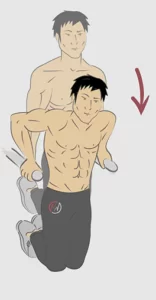
Resistance band pullover
- How to do it?
- For the Resistance band pullover exercise, you will need a resistance band to anchor it on some solid objects. Then, take the supine lying position with your head toward the anchor point. The band should be about 2 to 4 feet higher than your head.
- You have to hold the resistance band overhead so that there is slight tension on the resistance band. your thumbs should be pointing toward the ceilings and your palms facing away from each other.
- Your core muscles should be engaged and elbows extended, pull the resistance band toward your hips. Slowly return to the initial position with control.
- You can do 2 to 3 sets of 10 to 12 repetitions.
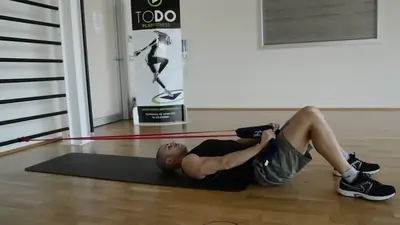
Chest Fly
- How to do it?
- For the Chest Fly exercise, you have to Lie on your back on a flat bench and hold dumbbells in both hands. Press the dumbbells up above the chest, keeping them from touching, with your little fingers and turned slightly inward. keep full-body tension on a bench.
- Lower your arms down moving only from your shoulders, keeping the slight elbow flexion. Only go as deep as your shoulder movement allows you. Squeeze your shoulder blades to raise the dumbbells back up to the starting position, and emphasize the squeeze in your chest at the top.
- You can do 1 to 2 sets of 10 to 15 repetitions
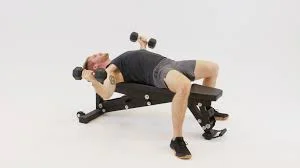
Dumbbell Floor Press
- How to do it?
- Take your dumbbell press to the ground for a shoulder-safe chest pump. This is another great variation for building up your chest muscles with home workouts since all you will need are some weights and some space to spread out.
- Lie on your back on the floor and hold a pair of dumbbells tightly. Keep your feet flat on the floor, driving with your heels and squeezing your buttocks. Keep your elbows at a 45 to 50-degree angle relative to your trunk to keep your shoulder muscles safe.
- Then Press the weight up and squeeze your chest muscles at the top movement. Lower back the weight with control, allowing your elbows to rest briefly on the ground.
- You can do 5 to 8 repetitions of 1 to 2 sets.
Band Chest Fly
- How to do it?
- For the Band Chest Fly exercise, you have to Attach two bands to a stable object, like a power rack or tower.
- Hold the ends of the resistance bands in both hands, wrapping around your palms. Take a staggered stance and standing position in the middle of the station. Your arms should be outstretched but slightly bent. Lean slightly forward at your hips and do not round your back.
- Without changing a bend in your arms, take your hands together.
- Then Slowly reverse the exercise, keeping the bands controlled.
- You can do 1 to 2 sets of 10 to 15 repetitions.
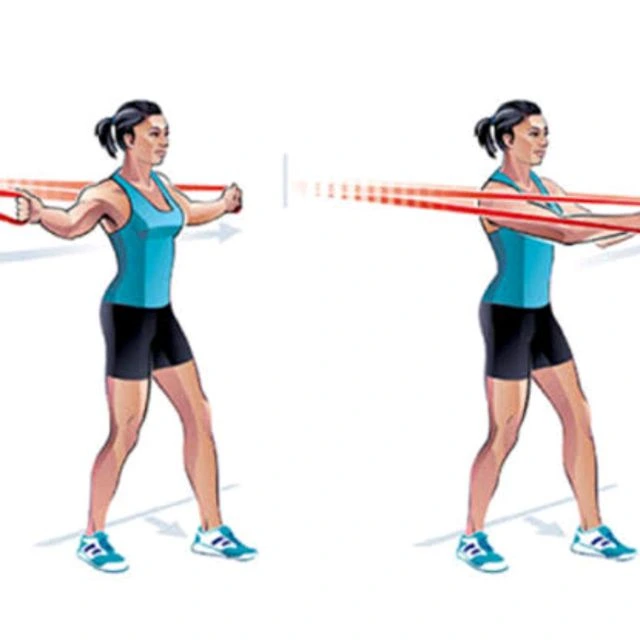
Batwing Fly
- How to do it?
- For the Batwing Fly exercise, you have to Sit on an incline bench holding dumbbells in both hands. Start with a dumbbell held with your hands at your pectoralis, as if you were preparing for a press.
- Keep the chest strong, with a natural arch in the back.
- Extend your arms out on both sides, maintaining your strong chest position.
- Then Pause for two seconds with your arms extended, stretching the muscles.
- You can do 2 to 4 sets of 8 to 12 repetitions.

Half-Kneeling Chest Press
- How to do it?
- For the Half-Kneeling Chest Press exercise, you have to Kneel with your right leg forward in front of a cable machine setup.
- Hold the cable with the same hand as the knee that is down on the ground. your core muscles should be tight and your left-knee straight, press the cable out in front of the chest.
- As you return your arm to the starting position, avoid turning with the cable by squeezing your core and stabilizing your hip against the ground.
- You can do 2 to 4 sets of 10 to 12 repetitions.
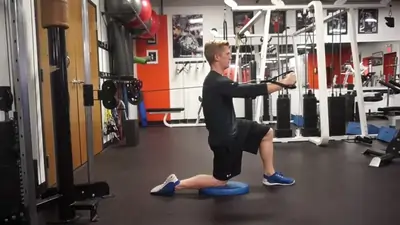
Close-Grip Bench Press
- How to do it?
- You can lift more weight with the barbell than with dumbbells because they are more stable. That is why barbell presses generally build more raw strength in the chest.
- But this variation puts more focus on your triceps muscle, so you will get the bonus of extra work for the biggest muscles in the arms, too.
- Using an overhand grip that is a bit narrower than the shoulder width, hold the barbell above your sternum with your arms straight.
- Lower the barbell to your chest then Hold for 1 to 2 seconds. Press the barbell up.
- You can do 1 to 3 sets of 6 to 10 repetitions.
Cable Fly
- How to do it?
- When people think about pectoral or chest strengthening they only think about a press but adding fly in this workout adds some new stimulus to the pectoralis and anterior deltoids.
- Fix two stirrup handles to the high-pulley cables of the cable-crossover station. hold a handle in both, and stand in the staggered stance in the middle of the station. keep your arms outstretched but slightly bent. Lean slightly forward at your hips; do not round your back.
- Without changing the flex in the arms, move your hands together. Slowly do this exercise in reverse.
- You can do 1 to 3 sets of 6 to 10 repetitions.
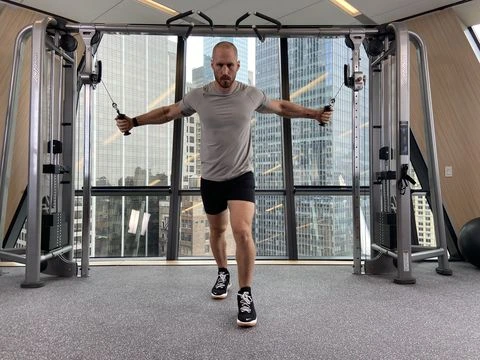
Stance Change Kneeling Fly
- How to do it?
- If you want to Target your lower chest then this is the best exercise. this exercise also works on your obliques. If you do not have a cable machine then you can use the resistance band, and wrap it on the stable object.
- For the Stance Change Kneeling Fly exercise, you have to Kneel in front of the resistance band’s anchor point, glutes and abdominals should be tight, with the left arm grasping the resistance band, and the right foot on the floor. Keeping your hips and shoulders square to the front and a slight bent in your elbow, do a fly rep by pulling the resistance band in front of your, wrist at about umbilicus height. pause for 2 seconds when you get to this position.
- Engage your core and shift your right leg back so you are kneeling on both knees.
- Shift back to the starting position. You have to Keep your hips and shoulders square to the front as you do this.
- Then Return the resistance band to the starting position.
- You can do 1 to 3 sets of 6 to 10 repetitions.
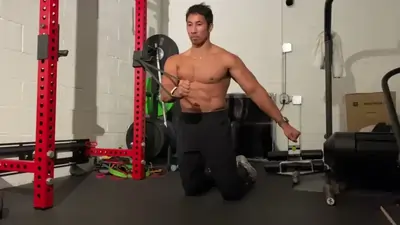
Plyometric Pushup
- How to do it?
- This explosive pushup works on a fast-twitch muscle in your chest, priming them for growth.
- This exercise also gives you another, more powerful option for at-home chest development.
- Start with a pushup position, your hands just outside your chest, your feet shoulder-width apart, and your body forming a straight line from the face to heels. Engage your core.
- Lower your chest to the ground and then press up explosively so your hands come from the ground.
- If you can pull it off, clap your hands together before returning to the beginning position on the floor.
- You can perform 2 to 3 sets of 8 to 10 repetitions.

Spider-Man Pushup
- How to do it?
- Begin with a pushup position, and your abdominals and glutes are contracted. Lower into a pushup, Then bring your chest an inch from the ground.
- Pause for a second in this position.
- Keeping your chest parallel to the ground, lift your left foot off the ground and drive your left knee to touch your left elbow.
- Drive back up as you return your left side leg to the standard pushup position. Repeat on the other side.
- You can do 2 to 4 sets of 6 to 8 repetitions.

Suspended Pushup
- How to do it?
- Do pushups with your hands in an unstable suspension trainer and utilize your core, chest, and stabilizer muscles harder than performing pushups on the floor. Using the TRX straps makes this another more accessible option for workouts at home.
- Hold the handles of the TRX strap and straighten your arms in front of your chest.
- You have to stand with shoulder-hip width apart and your body anywhere from 45 to 50 degrees parallel from the ground. from head to heels Your body should form a straight line.
- Lower your chest toward the ground until your hands are just outside of your shoulders. Keep your elbows in and keep your head in the neutral position as you lower the chest. Brace your core throughout this exercise.
- You can do 2 sets of 6 to 10 repetitions.
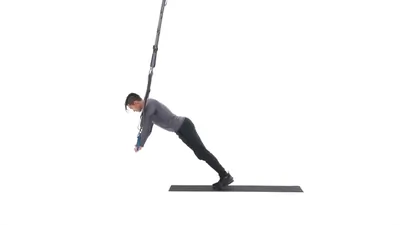
Standing One-Arm Landmine Press
- How to do it?
- Most chest presses exercise is to stress your shoulder muscles. This exercise nails your chest while increasing your shoulder joint mobility.
- Your shoulder blade moves with you as you press, it will put less stress on the joint.
- Because your core has to lock down to prevent your trunk from bending back or twisting, it also rocks your abdominals.
- Do this unique exercise by placing one end of the barbell securely into the corner, holding the opposite end with one arm. Stand with your feet shoulder-width apart, slightly bent the knees while pushing your buttocks back.
- Start with your elbow by your side with the wrist up near your shoulder. Brace your core muscles and press your arm straight up and out toward a ceiling.
- You can do 2 sets of 8 to 10 repetitions.
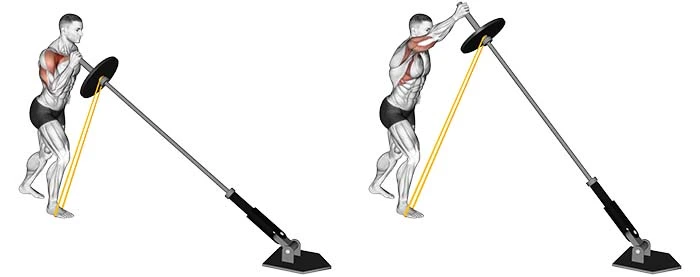
Bear Plank Chest Press
- How to do it?
- The Bear Plank Chest Press exercise flips your chest day upside down, challenging your stability and torching your core. You will need the cable machine or the pair of resistance bands set on high anchor points.
- Start with a bear plank position, bands set overhead or cable handles in your hands, core muscles should be braced. Keeping your hips and shoulders square to the ground and your back should be flat, shift one arm back towards your trunk then hold for a second.
- Then Press down to the ground, still keeping hips and shoulders square. Repeat this on another side.
- You can do 3 sets of 8 to 10 repetitions.
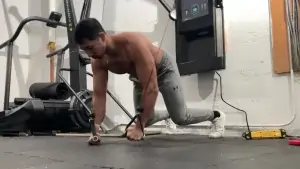
Stretching exercise
Kneeling chest opener stretch
Being in the kneeling position with your arms overhead will not only stretch out your chest but your shoulders and lattisimus dorsi too. Be careful not to overarch the lower back to achieve the bigger stretch. This is a big no.
- How to do:
- Have the chair or bench at around hip height and at arm’s length.
- Kneel down on your knees with your toes on the floor.
- Place your arms on the bench and put your head between your arms and slightly lower the head down.
- Actively reach forward to feel the better stretch.
- Static: You can hold for 30 seconds to two minutes
Dynamic: Move in and out of the stretch for 8 to 10 reps with short holds for each rep.

Standing arms backward chest stretch
Probably this is one of the easiest stretches to do but also one of the most effective chest stretches. This will also stretch the anterior shoulder and biceps muscle making it a great stretch of the upper body. Putting your arm behind your back may be painful so let pain be your guide when performing this stretch.
- How to do:
- Stand up straight with the shoulders down and chest up.
- Reach behind your back with your both arms and hold your hands together.
- Straighten your elbows and puff out your chest to feel a stretch.
- You can raise your arms up higher to feel a more intense stretch.
- Static: Hold for 30 to 60 seconds.
Dynamic: Hold for 10 seconds, then release, and repeat for 3 to 5 reps.
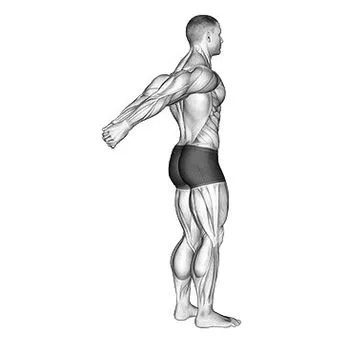
Standing bent arm door chest stretch
The classic doorway stretch is probably the best of all the chest stretches. This exercise opens up your chest muscles and anterior shoulder for better posture and shoulder mobility. Because the shoulder is in a vulnerable position be careful not to overstretch as this can hurt the shoulder joint.
- How to do:
- Stand side onto the doorway or door and stand tall.
- Bend your elbow 90 degrees and bring it up to shoulder height with your hand up and facing forward.
- Place your upper arm and elbow against the doorway and lean into it to feel the stretch in your chest.
- 30 seconds to one minute will work well.
- Repeat on the other side.
- Static: 30 to 60-second holds.
Dynamic: You can Hold for 5 to 10 seconds, then release. Repeat for several reps on each side.
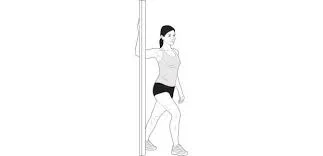
Standing straight arm chest stretch
Stretching your chest one side at a time is help you have mobility/flexibility differences between sides. This will stretch the shoulder and biceps muscles also and you can vary your intensity by how far you will reach back with your hand.
- How to do:
- Stand side onto the wall at arm’s length.
- Place your hand flat on the wall at shoulder height.
- Slide your hand back until you feel a stretch.
- Hold for 30 seconds to 1 minute.
- Repeat on the other side.
- Static: You can hold for 30 to 60 seconds.
Dynamic: Hold for 5 to 10 seconds, then release. Repeat for several reps on each side.
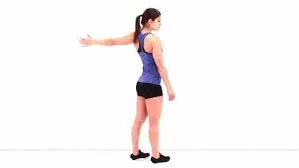
Seated shoulder extension stretch
Being on the floor in a seated position gives you increased stability to help you maximize the stretch of your chest muscles and anterior deltoid muscle. This is a great posture reset because this exercise encourages you to sit up straight to get the best out of the exercise.
- How to do:
- Sit on the ground with your knees bent at 90 degrees and your feet or heels on the ground.
- Lean back and place your hands on the floor with your chest up and shoulders down.
- You should feel a stretch in your chest, anterior shoulder, and biceps muscle.
- Static: You can hold for one to two minutes.
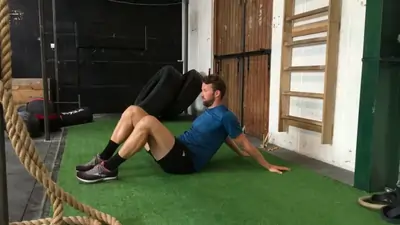
Chest opener and thoracic extension stretch
This one is similar to the kneeling chest opener stretch exercise, except you are standing, making more of a full-body stretch. Here you will feel the lower back and hamstrings muscle more because you are in a modified hinge position. If you are suffering from lower back pain or have any shoulder issues let pain, be your guide here. By the way, this one stretches through flexion of the shoulder, whereas the previous SEATED SHOULDER EXTENSION STRETCH exercise did so through shoulder extension, making them a good combination.
- How to do:
- Stand arm’s length to the weight bench or something solid at around hip height.
- Hinge back and reach your arms forward and hold the weight bench with your arms straight.
- Place your head between the arms and look at the floor.
- Feel the stretch in your chest, lats, upper back, and hamstrings.
- Static: You can hold for 30 seconds to two minutes
Dynamic: Move in and out of the stretch for 8 to 10 reps with short holds for each rep.
Dynamic chest and front of shoulder stretch
A nice simple dynamic stretch exercise that opens up the chest and anterior shoulder that contracts and stretches the chest to get it ready for the work ahead. Open up as far as you comfortably can, feeling the stretch in your pectorals. This is a good first exercise in the dynamic warm-up.
- How to do:
- Stand up tall and raise your arms at shoulder height and place the palms of the hands together.
- Move your arms horizontally apart to your arms to form a T.
- Feel your chest open up and return to the initial position.
- Do anywhere from 10 to 20 reps.

Dynamic arm crossover
Similar to the movement above except you are crossing over your arms and bending the elbows. This gets the biceps and upper back more involved while dynamically stretching the chest. Switching which arm is on top works great here for rhythm and balance.
- How to do:
- Start with your arms out to the side shoulder height with your hands facing the floor.
- Cross your arms over as you bring them around your torso by bending the elbows.
- Return to the initial position and repeat continuously for reps.
- here, 10 to 20 reps work well.
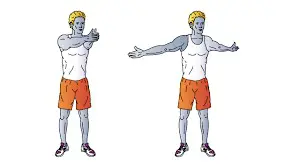
Towel Chest Stretch
- Have a towel or strap handy. Breathe normally as you stretch.
- Stand with good posture holding the towel behind your back.
- Lift the towel behind you by holding the ends with both hands.
- Use the towel to pull your shoulders into extension slowly. You can feel a stretch in the front of your chest. Squeeze the shoulder blades together to maximize a stretch.
- You can hold this position for 15 to 30 seconds and then relax.
- Repeat 2 or 3 times.

Standing wall bar chest stretch
Similar to the stretch above but you are holding something solid behind you at shoulder-width apart. This stretch will open up your chest more and you can make it more or less intense by raising or lowering the arms, depending on your mobility. This will stretch the anterior shoulder and biceps muscles also. Again, let discomfort be your guide.
- How to do:
- Wall bars are great but anything solid you can hold on to with the wrists in neutral works here.
- Stand up straight with a wall bar arm’s length behind you.
- Reach behind you and take a good grip with the hands shoulder-width apart.
- Puff out your chest to feel the stretch more.
- Static: You can hold for 30 seconds to 2 minutes.
Dynamic chest and front of shoulder stretch
The chest and shoulder stretch has you gripping the bar/Pvc/band at shoulder-width apart and moving back behind your head and back to your thighs. This helps you to open up your chest and anterior shoulder to get this area ready for the work ahead. Please Be careful not to get any extra range of motion by overarching your back. Here, Be guided by your shoulder mobility.
- How to do:
- Hold the bar (or resistance band or rope/towel) at arms-length and shoulder-width apart while standing up straight.
- Pull the bar up on top of the chin by bending your elbow.
- Externally rotate the shoulders to get the bar overhead.
- Open up your chest to feel the stretch and pause for a second.
- Return to the starting position and repeat for 6 to 12 reps.
Precaution of the chest muscles exercise
- All stretches for chest muscles can improve flexibility and increase your range of motion. Chest stretches also build strength so that you can perform better and lift heavier weights during your workout. But the correct precautions for chest stretches have to be taken or else you may end up doing more damage than good.
- Never working out a cold muscle
- Stretching a muscle is only effective if it has been warmed up and is pliable Otherwise the entire process of stretching can be a waste of time
- Hold each stretch for a minimum of 30 seconds Less than this and the muscle doesn’t even receive the signal from the brain to relax and lengthen, thus negating the point of the exercises
- As with any type of stretch, chest stretches should never be held to the point of pain
- Mild discomfort is the aim of a good stretch but if you feel any sharp or tearing pain, stop the exercise immediately
When did you not do these exercises?
- When your physician advised you to take rest.
- When you are suffering from back pain then avoid weight-lifting exercises.
- When you have a recent injury to the chest and shoulders.
- When you have breathlessness issues.
- When you feel any pain during these exercises then stop immediately and consult your therapist.
Chest exercises without equipment
- Regular push-ups
- Incline push-ups
- Decline push-ups
- Plyometric push-ups
- Time under tension push-ups
- Regular chest press
- Incline chest press
- Decline chest press
Pectoral muscle workout female
- Knee push-ups: This breast lift exercise works on the pectoralis major and tricep muscles
- Elbow squeeze shoulder press
- Dumbbell chest press
- Dumbbell plank rotation
- Downward dog
- Floor fly
- Cable crossover
- Incline bench press
- Floor fly
- Cable crossover
- Incline bench press
Chest exercises with dumbbells
Chest Fly
For the Chest Fly exercise, you have to Lie on your back on a flat bench and hold dumbbells in both hands. Press the dumbbells up above the chest, keeping them from touching, with your little fingers and turned slightly inward. keep full-body tension on a bench.
Lower your arms down moving only from your shoulders, keeping the slight elbow flexion. Only go as deep as your shoulder movement allows you. Squeeze your shoulder blades to raise the dumbbells back up to the starting position, and emphasize the squeeze in your chest at the top.
You can do 1 to 2 sets of 10 to 15 repetitions
Dumbbell Floor Press
Take your dumbbell press to the ground for a shoulder-safe chest pump. This is another great variation for building up your chest muscles with home workouts since all you will need are some weights and some space to spread out.
Lie on your back on the floor and hold a pair of dumbbells tightly. Keep your feet flat on the floor, driving with your heels and squeezing your buttocks. Keep your elbows at a 45 to 50-degree angle relative to your trunk to keep your shoulder muscles safe.
Then Press the weight up and squeeze your chest muscles at the top movement. Lower back the weight with control, allowing your elbows to rest briefly on the ground.
You can do 5 to 8 repetitions of 1 to 2 sets.
Batwing Fly
For the Batwing Fly exercise, you have to Sit on an incline bench holding dumbbells in both hands. Start with a dumbbell held with your hands at your pectoralis, as if you were preparing for a press.
Keep the chest strong, with a natural arch in the back.
Extend your arms out on both sides, maintaining your strong chest position.
Then Pause for two seconds with your arms extended, stretching the muscles.
You can do 2 to 4 sets of 8 to 12 repetitions.
Chest exercises at home
- Regular push-ups
- Incline push-ups
- Decline push-ups
- Plyometric push-ups
- Time under tension push-ups
- Regular chest press
- Incline chest press
- Decline chest press
Upper chest exercises
- Low-to-High Cable or Band Flye
- Converging Incline Machine Press
- Dumbbell Incline Press with Semi-Pronated Grip
- Swiss-Bar Incline Press
- Incline Dumbbell Flye
Lower chest exercises
- Incline pushup
- Decline dumbbell press
- Decline dumbbell bench press with external rotation
- Cable crossover
- Parallel-bar dips (chest)
Chest exercises gym
- Incline pushup
- Flat bench press
- Incline bench press
- Decline bench press
- Pushup
- Cable crossover
- Chest dip
- Resistance band pullover
FAQ
Incline pushup, Flat bench press, Incline bench press, Decline bench press, Pushup, Cable crossover, Chest dip, and Resistance band pullover exercise builds the most chest muscle. For the Band Chest Fly exercise, you have to Attach two bands to a stable object, like a power rack or tower. Hold the ends of the resistance bands in both hands, wrapping around your palms. Take a staggered stance and standing position in the middle of the station. Your arms should be outstretched but slightly bent. Lean slightly forward at your hips and do not round your back. Without changing a bend in your arms, take your hands together. Then Slowly reverse the exercise, keeping the bands controlled. You can do 1 to 2 sets of 10 to 15 repetitions.
The first exercise to strengthen your chest muscles is Pushup, Start on your hands and knees, and step back into the high plank position. keep your hands wider than the shoulders, and your legs should be straight with your quadriceps. Your hamstrings muscle should be engaged and your spine should be neutral. Your core muscles should be tight, Bend your elbows up to a 45 to 50-degree angle to lower your chest toward the ground, maintaining a straight line from the head to heel. the main goal is to go as low as you can without losing the support of your core muscles or the alignment of your spine and pelvis. Press your chest away from the ground until your elbows are extended. Repeat, completing 10 to 15 repetitions. Do 2 to 3 sets. If you want to make this exercise more challenging, then you can do the decline pushup by placing your toes on an elevated surface such as a bench or table. The second exercise is the Incline bench press, For an Incline bench press, you need a barbell or dumbbell, and an incline bench. Lie on your back on the incline bench with your knees bent and feet flat on the ground. hold the dumbbells, with your thumb wrapped around the dumbbells and palms facing toward the feet. Press your arms straight toward the sky to lift the barbell from the rack. Slowly lower the dumbbells down to your chest, approximately in line with your mid-chest to just above your fourth intercostal space. Pause, then press the weight back to the starting position. You can Complete 3 sets of 10 to 14 repetitions. and the third exercise is Cable crossover, For the Cable crossover, you will need a cable machine or a resistance band. For this exercise, you have to stand away from a set of a high pulley cable machine or the resistance band anchored overhead. Select light to moderate weight to add some more challenge but give you proper form. Hold the ends of the resistance band as you step forward with one foot. You have to create enough tension and control on the handles to keep them in front of your body. Engage your chest muscles and bring the handles down and forward across your body roughly up to your umbilicus. The hands can cross to add emphasis on the serratus anterior muscles. can hold for two to three seconds and then slowly return to the starting position. Then repeat. Do 2 sets of 16 to 20 repetitions.
You can build your chest muscle t home by doing Standard Push-ups, Slightly Easier Push-ups, Decline Push-ups, Plyometric Push-ups, Wide Push-ups, Diamond Push-ups
Shuffle Push-ups, One-leg Push-ups and Incline push up. Incline push up are a very good exercise to warm up your chest muscles for work. For the Incline push-up exercise, you have to begin with your hands on the wall or a countertop-height surface. move your feet back so that your body makes roughly a 45 to 50-degree angle with the ground. Your body should be straight and also your spine should be neutral, and lower your chest to the surface you are leaning against. You can hold for two seconds, then return to the beginning position. You have to Make sure the resistance feels light enough to complete up to 25 reps. If you want to make this exercise easier, step closer to your hands to make this exercise tough, step farther away.
the 5 primary exercises for the chest muscle group are the Flat Barbell Bench Press, Incline Dumbell Bench Press, Bodyweight Dips, Cable Chest Fly, and Push-Ups. For the Band Chest Fly exercise, you have to Attach two bands to a stable object, like a power rack or tower. Hold the ends of the resistance bands in both hands, wrapping around your palms. Take a staggered stance and standing position in the middle of the station. Your arms should be outstretched but slightly bent. Lean slightly forward at your hips and do not round your back. Without changing a bend in your arms, take your hands together. Then Slowly reverse the exercise, keeping the bands controlled. You can do 1 to 2 sets of 10 to 15 repetitions.
the number 1 chest exercise is the Incline bench press. For an Incline bench press, you need a barbell or dumbbell, and an incline bench. Lie on your back on the incline bench with your knees bent and feet flat on the ground. hold the dumbbells, with your thumb wrapped around the dumbbells and palms facing toward the feet. Press your arms straight toward the sky to lift the barbell from the rack. Slowly lower the dumbbells down to your chest, approximately in line with your mid-chest to just above your fourth intercostal space. Pause, then press the weight back to the starting position. You can Complete 3 sets of 10 to 14 repetitions.
You should perform 1 to 4 chest exercises per workout, with the most optimal range being 2 to 3 different chest exercises in a single training session. Why? For most lifters, performing any more than 3 to 4 various movements can result in diminished returns, excessive “trash” volume, and suboptimal quality volume.

